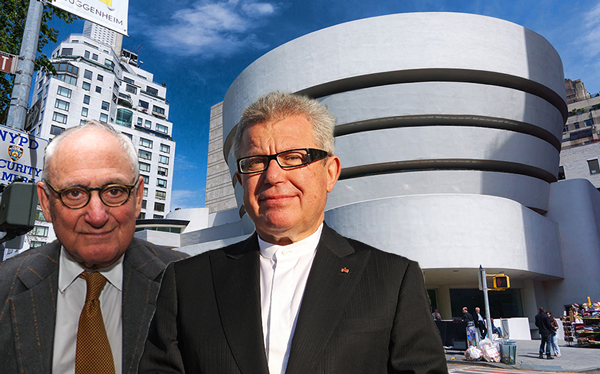
The Guggenheim Museum, Robert A.M. Stern and Daniel Libeskind
Three renowned architects took the stage Friday at the 92nd Street Y and agreed about nearly nothing.
Robert A.M. Stern, Billie Tsien and Daniel Libeskind discussed designing museums and the cultural impact of these buildings, as part of Hundred Stories’ City of Tomorrow Real Estate Architecture and Design Summit. From the start, Stern and Libeskind clashed on nearly every topic raised by the moderator. At one point, Tsien jokingly offered to sit between the two men as a buffer.
Stern, who designed the Museum of the American Revolution and the George W. Bush Presidential Center, lamented that few art museums provide the silence and solitude that places like the Frick Collection offer. He called the atrium at the Museum of Modern Art a nightmare in the form of a “24/7 cocktail party.” He’s also not a fan of climbing the ramps of Frank Lloyd Wright‘s “temple of the spirit.”
“The Guggenheim is a fabulous building, but it’s mostly a terrible place to look at art,” he said.
He said too many museums “think they are in show business” and put too much energy into gift shops and dining areas.
“You can hardly go anywhere without having the smell of food pervading the gallery,” he said. “I think the experience of being with a work of art is still very, very important. And I think young people will grow into it.”
Libeskind, who designed the master plan for the World Trade Center and the Jewish Museum in Berlin, countered that the idea of art is too romanticized.
“Maybe the whole view of art is changing, away from this old view that we have inherited and more into the realm of fun and celebration, entertainment even,” he said. “Did Picasso paint for the white walls of the MoMa? Or did he paint for pleasure and great sense of openness?”
The panelists also discussed the role of public input in the designing process. Tsien who, along with her husband Tod Williams, was selected to design President Barack Obama’s Presidential Center, said that she’s found it important to both listen and filter comments and criticism about the highly contentious project.
“[For] public buildings, civic buildings, as architects, we need to listen to the communities that are going to be using it,” she said. “At the same time, I don’t think you need to look at what people are saying about that on it on Twitter. That’s not helpful. It’s also primarily anonymous, and it’s also mostly uninformed.”
Stern said that public involvement is an unavoidable reality of “modern times.”
“We can’t have a building designed by Instagram followers either,” he said. “There’s an old saying in architecture that a camel is a horse designed by a committee.”
Libeskind said he’s generally a fan of public involvement.
“I think when people are involved in a participatory way, that’s good for architecture,” he said. “I think the architecture that is produced in those elitist rooms upstairs is not my favorite.”
When asked if anything’s surprised her about the process of designing the library in Chicago, Tsien noted that she was not expecting the former president and first lady to be as involved in designing the library as they are.
Stern noted that presidential libraries are particularly controversial because they are physical representations of the politician’s policies. He said someone, after all, will design President Trump’s museum when the time comes.
“Nobody,” Tsien replied.
Libeskind and Stern also didn’t agree on the subject of the removal of monuments and statues that celebrate controversial figures, like Confederate officials or Christopher Columbus. Stern said he felt that removing all such statues was a form of erasing history and suggested putting a plaque next to the monuments explaining the unsavory actions of those who are memorialized.
Libeskind asked if Stern felt the same way about Adolf Hitler’s bunker in Berlin. Stern said he wasn’t sure.
“Oh my god,” Libeskind said.
Tsien chimed in that the problem with leaving the statues — even when accompanied by a plaque providing context — is that they are culturally recognized as a way of honoring historical figures.
After the hour-long sparring session, Libeskind and Stern left the stage with their arms around each other.



